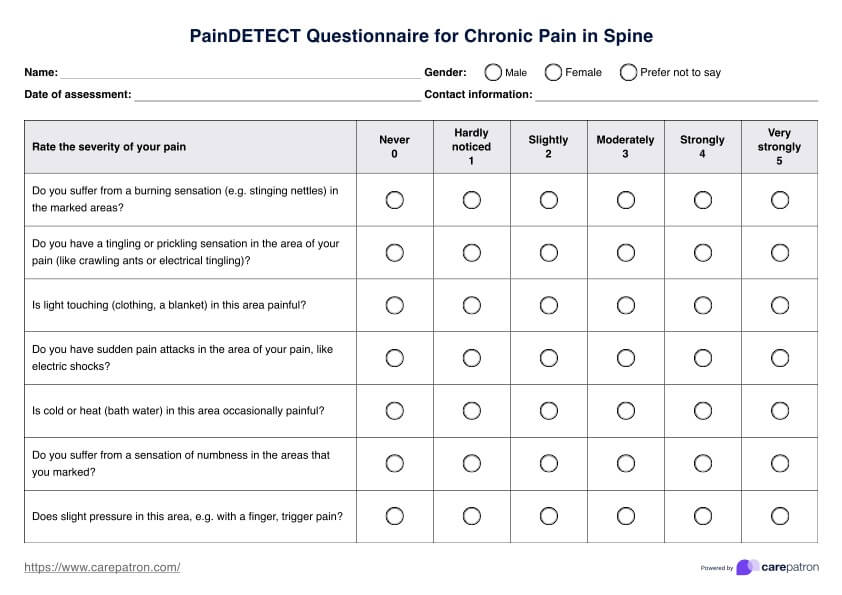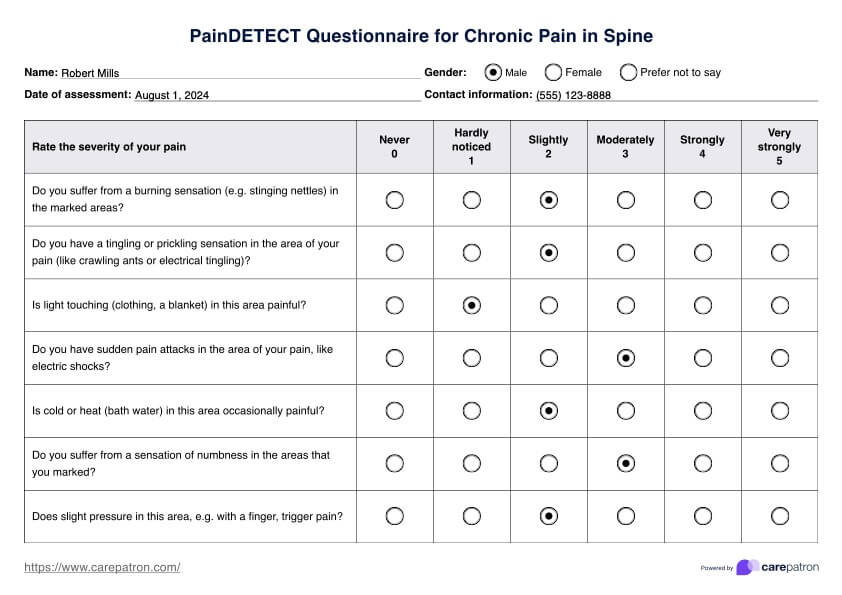PainDETECT Questionnaire for Chronic Pain in Spine
Download a PDF copy of the PainDETECT Questionnaire for Chronic Pain in Spine to assess neuropathic-like symptoms.


What is PainDETECT?
PainDETECT is a widely recognized screening questionnaire designed to detect neuropathic pain, particularly in patients with spine-related disorders. Developed by Freynhagen and colleagues in 2006, this self-administered tool has become an invaluable asset in both clinical practice and research settings.
This relatively new screening questionnaire consists of nine items that assess various aspects of pain, including intensity, pattern, and associated sensations. By evaluating these factors, PainDETECT helps differentiate between a nociceptive and a neuropathic pain component, which is crucial for effective treatment planning.
This could be a helpful tool in your clinical work, especially when working with chronic pain patients or those who may experience chronic low back pain, knee osteoarthritis, and other forms of musculoskeletal pain.
PainDETECT Questionnaire for Chronic Pain in Spine Template
PainDETECT Questionnaire for Chronic Pain in Spine Example
What are the 4 types of pain?
Pain is a complex experience that can manifest in various forms. In the context of chronic spine conditions, recognizing the different types of pain is crucial for accurate diagnosis and effective treatment. Here are the four main types of pain often encountered in clinical practice:
Nociceptive pain
Nociceptive pain is the most common type of pain. It occurs when nociceptors—specialized nerve endings that detect potentially harmful stimuli—are activated by tissue damage or inflammation. In spine conditions, this type of pain often results from injuries to muscles, ligaments, or bones.
Neuropathic pain
Administering the PainDETECT questionnaire can help identify neuropathic pain that arises from damage or dysfunction in the nervous system itself. This can involve the peripheral nerves, spinal cord, or brain. In spine conditions, neuropathic pain often results from nerve compression or injury. Neuropathic pain symptoms include pain often described as burning, electric, or shooting. This may be accompanied by numbness, tingling, or weakness and can be challenging to treat with conventional pain medications.
Nociplastic pain
Nociplastic pain is a relatively new classification. It refers to pain that arises from altered nociception despite no clear evidence of actual or threatened tissue damage or disease or lesion of the somatosensory system.
Mixed pain
Mixed pain refers to situations where more than one pain type coexists. This is particularly common in chronic spine conditions, where patients may experience a combination of nociceptive, neuropathic, and/or nociplastic pain.
How to use this screening questionnaire to identify neuropathic components in patients
The PainDETECT questionnaire is valuable for identifying neuropathic pain components in patients with chronic spine conditions. Here's a guide on how to implement this screening tool effectively in clinical practice:
Step 1: Administer the questionnaire
Provide the patient with the self-administered PainDETECT questionnaire. Ensure the patient understands the instructions and has the privacy to complete them. The questionnaire typically takes about 5 minutes to complete.
Step 2: Score the responses
Collect the completed questionnaire and calculate the total score. Based on the patient's responses to nine items, the scoring system ranges from -1 to 38 points. Pay particular attention to the pain course pattern, radiation, and sensory descriptors.
Step 3: Interpret the results
Categorize the score into one of three groups: neuropathic pain components unlikely, unclear, or likely present. Consider the score in conjunction with clinical findings and patient history.
Step 4: Plan further assessment and treatment
For scores ≥ 19, consider further neuropathic pain-specific assessments or treatments. For ambiguous scores (13-18), use clinical judgment to determine if additional evaluation is needed. It is important to remember that PainDETECT is a screening tool and should not replace comprehensive clinical examination. This can be used alongside the Leeds Assessment of Neuropathic Symptoms and Signs (LANNS) and the Neuropathic Pain Symptom Inventory (NPSI).
How to score the pain detect questionnaire
To score the PainDETECT questionnaire, follow these steps:
- Each of the 7 sensory descriptor items scored from 0 (never) to 5 (very strongly). These scores are multiplied by a weighting factor for each item, ranging from -1 to +2. The weighted scores are then summed, resulting in a total score between 0 and 28 for this section.
- The scores for the 2 items relating to spatial and temporal pain characteristics are -1, 0, or +1, depending on the response. These scores are added to the total from Step 1.
- The final score ranges from -1 to 38, calculated based on the 9 items in the last 3 domains. A score ≤12 suggests neuropathic pain is unlikely, a score between 13-18 indicates an unclear neuropathic component, and a score ≥19 suggests a probable neuropathic component.
The PainDETECT questionnaire is a valuable tool for assessing the likelihood of neuropathic pain in patients with chronic spinal pain. This can also help identify neuropathic pain components. By accurately scoring the questionnaire and interpreting the results, healthcare practitioners can better understand pain intensity, the nature of radiating pain, and neuropathic symptoms if present.
Commonly asked questions
PainDETECT is a self-administered screening questionnaire used to assess the likelihood of neuropathic pain components in patients with chronic pain conditions like low back pain, osteoarthritis, and rheumatoid arthritis. It consists of 9 items that evaluate the quality, severity, course, and radiating nature of the patient's pain.
The PainDETECT scoring ranges from -1 to 38. A score of ≤12 suggests neuropathic pain is unlikely, a score of 13-18 indicates an unclear neuropathic component and a score of ≥19 suggests a probable neuropathic pain component.
Yes, it is possible to live with chronic nerve pain, though it can significantly impact quality of life. Chronic neuropathic pain is often difficult to manage and may require a multidisciplinary approach involving medications, physical therapy, psychological interventions, and other treatments tailored to the individual patient.







































































































